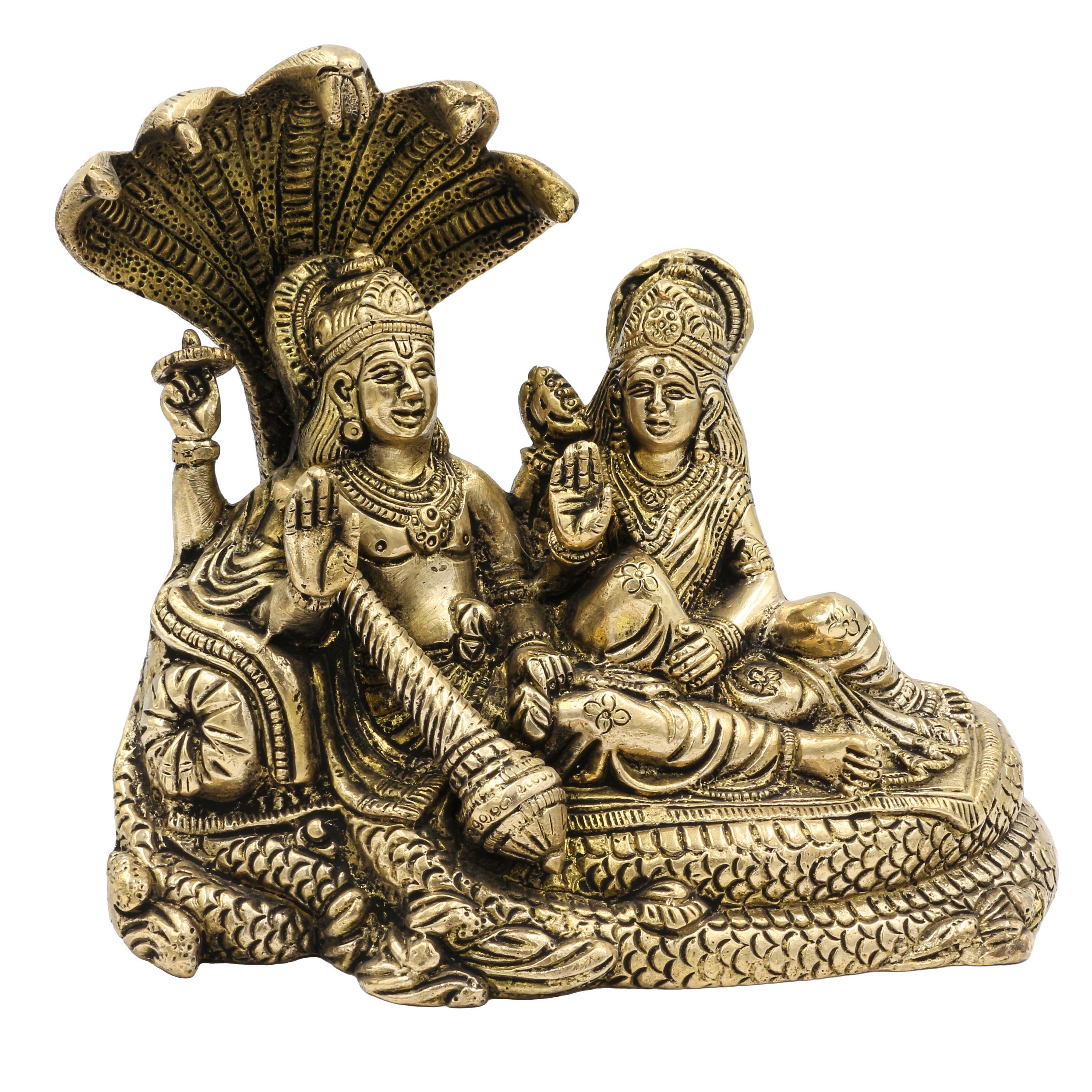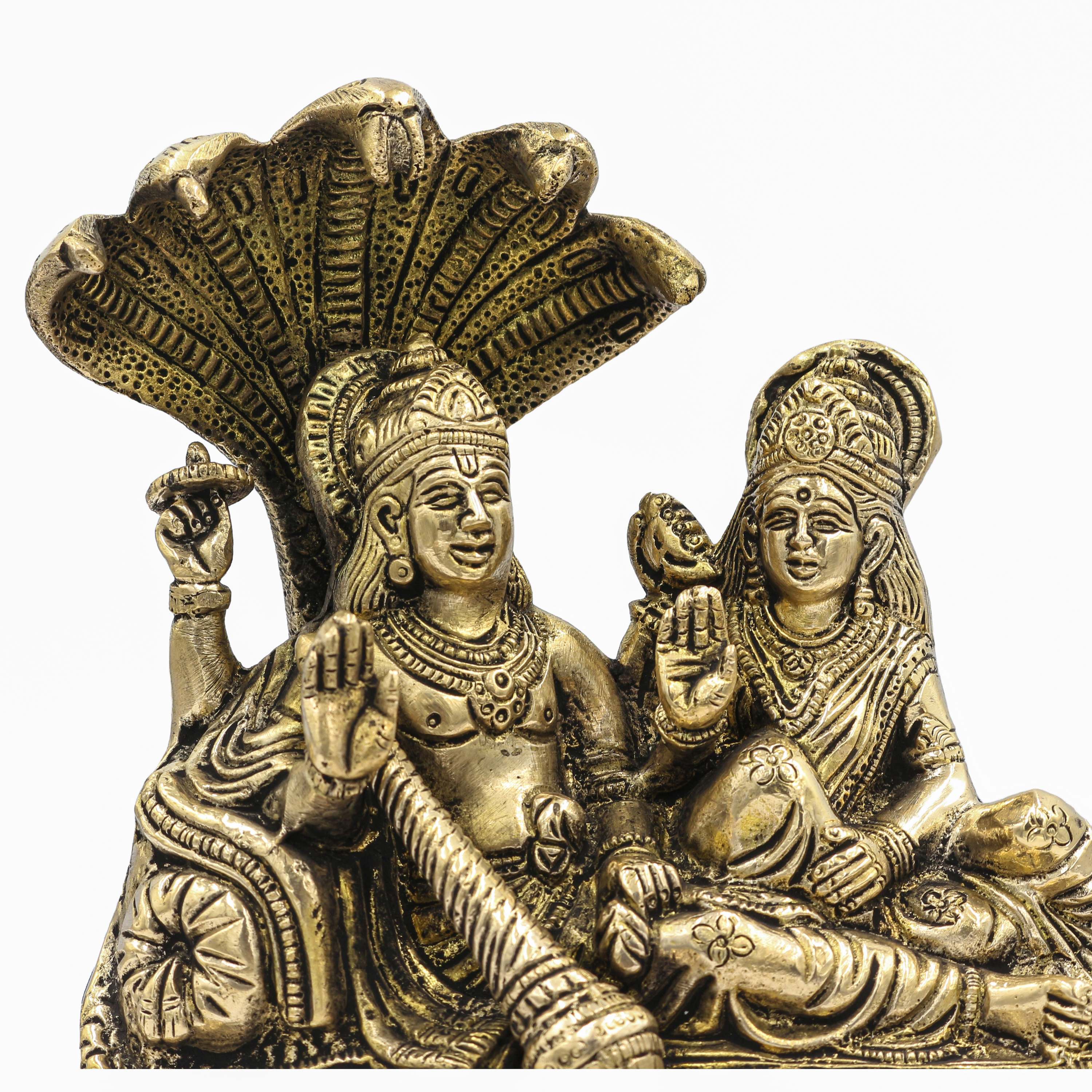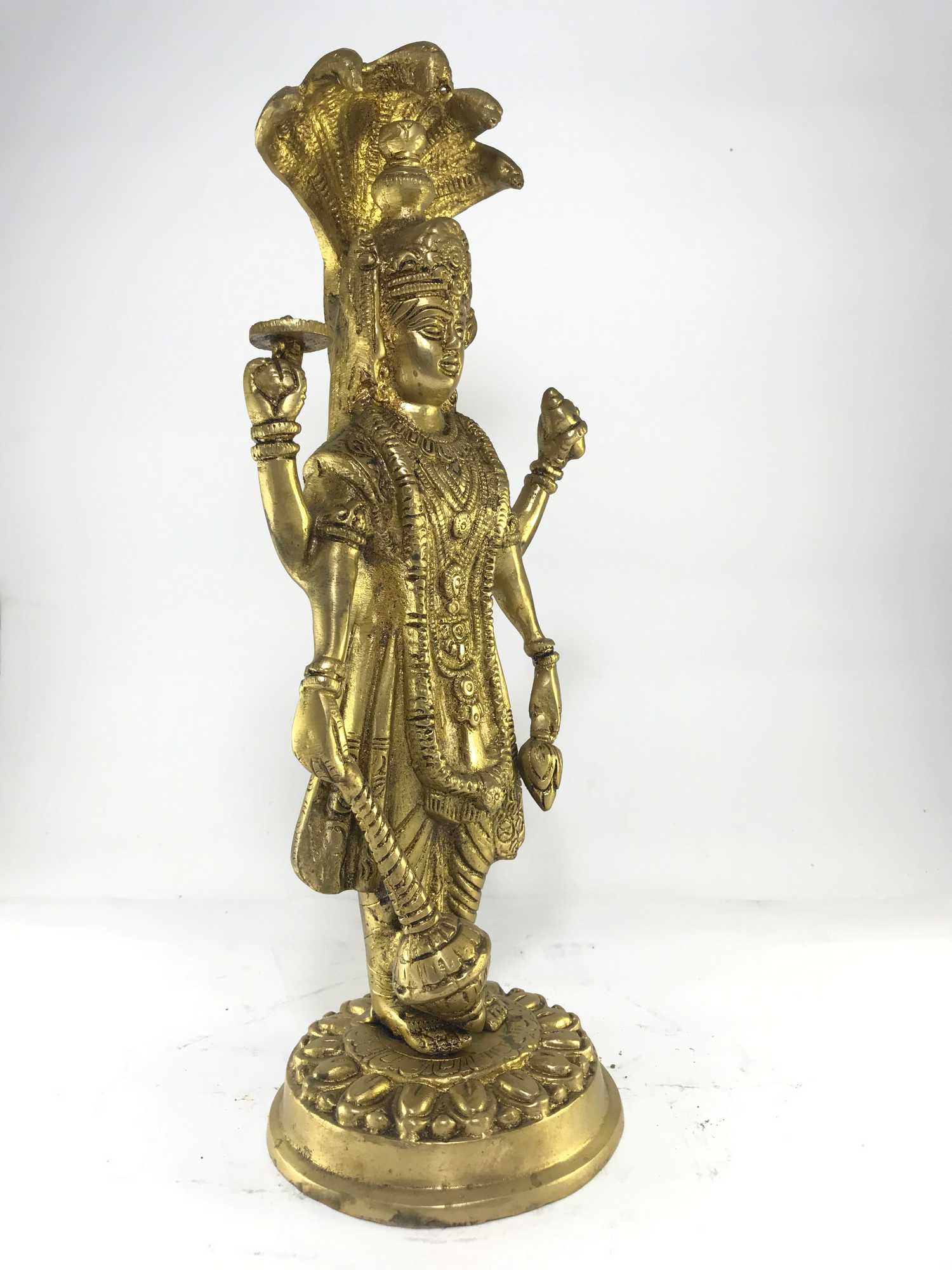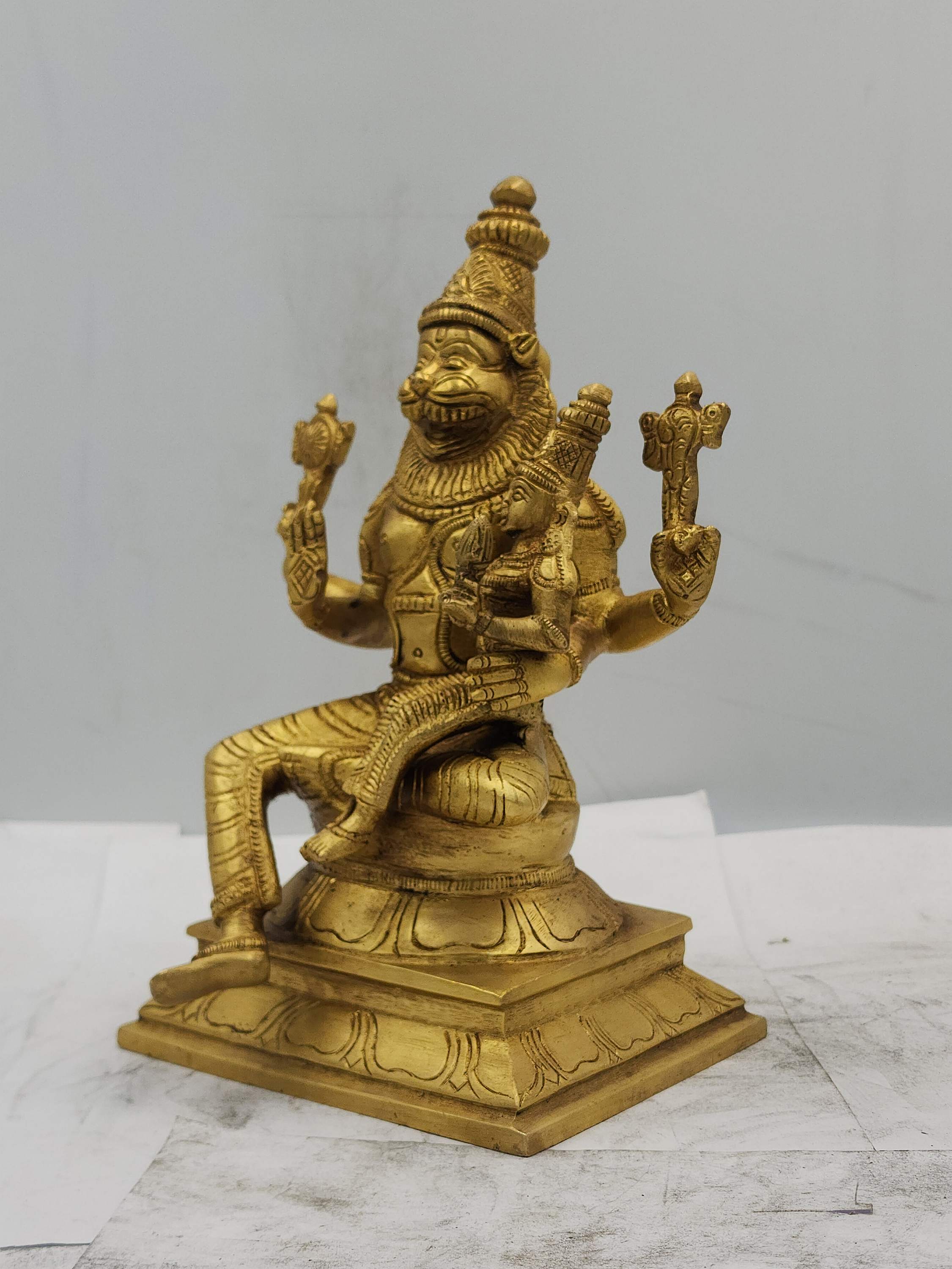Code
HCS18323
Weight
382 gm / 0.84 lbs
Size
Height
15cm (6") Width
7cm (3") Depth
6cm (2") Material
Brass
Availability
Available
Date Added
2020-03-15 02:10:28
Note : We used to sell this product 5 years ago so it may no longer be in our stock.
It is possible that we still have it with our suppliers but the price could be different from before.
Feel free to order. We will verify availability and inform you promptly.
It is possible that we still have it with our suppliers but the price could be different from before.
Feel free to order. We will verify availability and inform you promptly.

Safe Payment
We accept Paypal, Money Transfer, Bank Transfer
Confidence
Protection covers your purchase and personal data.
Worldwide Delivery
We ship Worldwide, except Russia.Shipping cost US$25.2 for upto 0.5 kgs

Hotline
Talk to help line for your question on 9841267335Process: Sand Casting
This Statue Of Vishnu, [antique Finishing] has been created using the sand casting system, also known as sand molding casting. This widely employed manufacturing process utilizes a sand mold to produce metal products and components in various sizes and shapes. Sand casting holds significant popularity in the industry, accounting for approximately 60% of all metal castings. The sand casting process involves six primary steps. First, a pattern or replica of the desired sculpture, in this case, Statue Of Vishnu, [antique Finishing], is created using a material like wood or metal. The pattern is then placed in a flask, which is a box-like structure divided into two halves. The next step involves packing the flask tightly with specially formulated molding sand, creating a mold cavity that matches the shape of the pattern. The pattern is subsequently removed, leaving behind a negative impression of the sculpture within the sand mold. Read More . . .
This Statue Of Vishnu, [antique Finishing] has been created using the sand casting system, also known as sand molding casting. This widely employed manufacturing process utilizes a sand mold to produce metal products and components in various sizes and shapes. Sand casting holds significant popularity in the industry, accounting for approximately 60% of all metal castings. The sand casting process involves six primary steps. First, a pattern or replica of the desired sculpture, in this case, Statue Of Vishnu, [antique Finishing], is created using a material like wood or metal. The pattern is then placed in a flask, which is a box-like structure divided into two halves. The next step involves packing the flask tightly with specially formulated molding sand, creating a mold cavity that matches the shape of the pattern. The pattern is subsequently removed, leaving behind a negative impression of the sculpture within the sand mold. Read More . . .
Iconography :
Vishnu is one of the most significant deities in Hinduism. He is the Supreme god Svayam Bhagavan of Vaishnavism (one of the principal denominations of Hinduism). He is also known as Narayana and Hari. As one of the five primary forms of God in the Smarta tradition, he is conceived as "the Preserver or the Protector"
In Hindu sacred texts, Vishnu is usually described as having dark complexion of water-filled clouds and having four arms. He is depicted as a pale blue being, as are his incarnations Rama and Krishna. He holds a padma (lotus flower) in his lower left hand, the Kaumodaki gada (mace) in his lower right hand, the Panchajanya shankha (conch) in his upper left hand and the discus weapon considered to be the most powerful weapon according to Hindu Religion Sudarshana Chakra in his upper right hand.
Dashavatara - 10 Incarnations :In Hindu sacred texts, Vishnu is usually described as having dark complexion of water-filled clouds and having four arms. He is depicted as a pale blue being, as are his incarnations Rama and Krishna. He holds a padma (lotus flower) in his lower left hand, the Kaumodaki gada (mace) in his lower right hand, the Panchajanya shankha (conch) in his upper left hand and the discus weapon considered to be the most powerful weapon according to Hindu Religion Sudarshana Chakra in his upper right hand.
1. Matsya (The fish)
1. Matsya, the fish, from the Satya Yuga. Vishnu takes the form of a fish to save Manu from the deluge, after which he takes his boat to the new world along with one of every species of plant and animal, gathered in a massive cyclone.
2. Kurma
Kurma, the tortoise, from the Satya Yuga. When the devas and asuras were churning the Ocean of milk in order to get amrita, the nectar of immortality, the mount Mandara they were using as the churning staff started to sink and Vishnu took the form of a tortoise to bear the weight of the mountain.
3. Varaha
Varaha, the boar, from the Satya Yuga. He appeared to defeat Hiranyaksha, a demon who had taken the Earth, or Prithvi, and carried it to the bottom of what is described as the cosmic ocean in the story. The battle between Varaha and Hiranyaksha is believed to have lasted for a thousand years, which the former finally won. Varaha carried the Earth out of the ocean between his tusks and restored it to its place in the universe.
4. Narsimha
Narasimha, the half-man/half-lion, from the Satya Yuga. The rakshasa (Demon) Hiranyakashipu, the elder brother of Hiranyaksha, was granted a powerful boon from brahma, not allowing him to be killed by man or animal, inside or out, day or night, on earth or the stars, with a weapon either living or inanimate. Vishnu descended as an anthropomorphic incarnation, with the body of a man and head and claws of a lion. He then disembowels the rakshasa at the courtyard threshold of his house, at dusk, with his claws, while he lay on his thighs.
5. Vamana
Vamana, a boy, from the Satya Yuga. The fourth descendant of Hiranyakashyap, Bali, with devotion and penance was able to defeat Indra, the god of firmament. This humbled the other deities and extended his authority over the three worlds. The gods appealed to Vishnu for protection and he descended as a boy Vamana. During a yajna (यज्ञ )of the king, Vamana approached him and Bali promised him for whatever he asked. Vamana asked for three paces of land. Bali agreed, and the dwarf then changed his size to that of a giant. He stepped over heaven in his first stride, and the netherworld with the second. Bali realized that Vamana was Vishnu incarnate. In deference, the king offered his head as the third place for Vamana to place his foot. The avatar did so and thus granted Bali immortality. Then in appreciation to Bali and his grandfather Prahlada, Vamana made him ruler of Pathala, the netherworld.
6. Parashurama
Parashurama, warrior with the axe, from the Satya Yuga. He is son of Jamadagni and Renuka and received an axe after a penance to Shiva. He is the first Brahmin-Kshatriya in Hinduism, or warrior-saint, with duties between a Brahmana and a Kshatriya). King Kartavirya Arjuna and his army visited the father of Parashurama at his ashram, and the saint was able to feed them with the divine cow Kamadhenu. The king demanded the cow, Jamadagni refused, and the king took it by force and destroyed the ashram. Parashurama then killed the king at his palace and destroyed his army. In revenge, the sons of Kartavirya killed Jamadagni. Parashurama took a vow to kill every Kshatriya on earth twenty-one times over, and filled five lakes with their blood. Ultimately, his grandfather, rishi Rucheeka, appeared and made him halt. He is a Chiranjeevi (immortal), and believed to be alive today in penance at Mahendragiri.
7. Rama
Rama, the prince and king of Ayodhya, from the Treta Yuga. He is a commonly worshiped avatar in Hinduism, and is thought of as the ideal heroic man. His story is recounted in one of the most widely read scriptures of Hinduism, the Ramayana. While in exile from his own kingdom with his brother Lakshman and the monkey God Hanuman, his wife Sita was abducted by the demon king of Lanka, Ravana. He travelled to Ashoka Vatika in Lanka, killed the demon king and saved Sita.
8. Krishna
Krishna was the eighth son of Devaki and Vasudev, from the Dwapara Yuga. He is also a frequently worshiped deity in Hinduism and an avatar in Vaishnava belief. He appeared alongside his elder brother Balarama. Balarama is regarded generally as an avatar of Shesha. However, Balarama is included as the eighth avatar of Vishnu in the Sri Vaishnava lists, where Buddha is omitted and Krishna appears as the ninth avatar in this list. He particularly included in the lists, where Krishna is removed and becomes the source of all avatars.
9. Buddha
Buddha: Gautama Buddha, the founder of Buddhism, is generally included as an avatar of Vishnu in Hinduism. Buddha may be depicted in Hindu scriptures as a preacher who deludes and leads demons and heretics away from the path of the Vedic scriptures. Another view praises him as a compassionate teacher who preached the path of ahimsa (non-violence).
10. Kalki
Kalki ("Eternity", or "White Horse", or "Destroyer of Filth"), will be the final incarnation of Vishnu, foretold to appear at the end of Kali Yuga, our present epoch. He will be atop a white horse and his sword will be drawn, blazing like a comet. He is the harbinger of end time in Hindu eschatology, and will destroy all unrighteousness and evil at the end of Kali Yuga.
1. Matsya, the fish, from the Satya Yuga. Vishnu takes the form of a fish to save Manu from the deluge, after which he takes his boat to the new world along with one of every species of plant and animal, gathered in a massive cyclone.
2. Kurma
Kurma, the tortoise, from the Satya Yuga. When the devas and asuras were churning the Ocean of milk in order to get amrita, the nectar of immortality, the mount Mandara they were using as the churning staff started to sink and Vishnu took the form of a tortoise to bear the weight of the mountain.
3. Varaha
Varaha, the boar, from the Satya Yuga. He appeared to defeat Hiranyaksha, a demon who had taken the Earth, or Prithvi, and carried it to the bottom of what is described as the cosmic ocean in the story. The battle between Varaha and Hiranyaksha is believed to have lasted for a thousand years, which the former finally won. Varaha carried the Earth out of the ocean between his tusks and restored it to its place in the universe.
4. Narsimha
Narasimha, the half-man/half-lion, from the Satya Yuga. The rakshasa (Demon) Hiranyakashipu, the elder brother of Hiranyaksha, was granted a powerful boon from brahma, not allowing him to be killed by man or animal, inside or out, day or night, on earth or the stars, with a weapon either living or inanimate. Vishnu descended as an anthropomorphic incarnation, with the body of a man and head and claws of a lion. He then disembowels the rakshasa at the courtyard threshold of his house, at dusk, with his claws, while he lay on his thighs.
5. Vamana
Vamana, a boy, from the Satya Yuga. The fourth descendant of Hiranyakashyap, Bali, with devotion and penance was able to defeat Indra, the god of firmament. This humbled the other deities and extended his authority over the three worlds. The gods appealed to Vishnu for protection and he descended as a boy Vamana. During a yajna (यज्ञ )of the king, Vamana approached him and Bali promised him for whatever he asked. Vamana asked for three paces of land. Bali agreed, and the dwarf then changed his size to that of a giant. He stepped over heaven in his first stride, and the netherworld with the second. Bali realized that Vamana was Vishnu incarnate. In deference, the king offered his head as the third place for Vamana to place his foot. The avatar did so and thus granted Bali immortality. Then in appreciation to Bali and his grandfather Prahlada, Vamana made him ruler of Pathala, the netherworld.
6. Parashurama
Parashurama, warrior with the axe, from the Satya Yuga. He is son of Jamadagni and Renuka and received an axe after a penance to Shiva. He is the first Brahmin-Kshatriya in Hinduism, or warrior-saint, with duties between a Brahmana and a Kshatriya). King Kartavirya Arjuna and his army visited the father of Parashurama at his ashram, and the saint was able to feed them with the divine cow Kamadhenu. The king demanded the cow, Jamadagni refused, and the king took it by force and destroyed the ashram. Parashurama then killed the king at his palace and destroyed his army. In revenge, the sons of Kartavirya killed Jamadagni. Parashurama took a vow to kill every Kshatriya on earth twenty-one times over, and filled five lakes with their blood. Ultimately, his grandfather, rishi Rucheeka, appeared and made him halt. He is a Chiranjeevi (immortal), and believed to be alive today in penance at Mahendragiri.
7. Rama
Rama, the prince and king of Ayodhya, from the Treta Yuga. He is a commonly worshiped avatar in Hinduism, and is thought of as the ideal heroic man. His story is recounted in one of the most widely read scriptures of Hinduism, the Ramayana. While in exile from his own kingdom with his brother Lakshman and the monkey God Hanuman, his wife Sita was abducted by the demon king of Lanka, Ravana. He travelled to Ashoka Vatika in Lanka, killed the demon king and saved Sita.
8. Krishna
Krishna was the eighth son of Devaki and Vasudev, from the Dwapara Yuga. He is also a frequently worshiped deity in Hinduism and an avatar in Vaishnava belief. He appeared alongside his elder brother Balarama. Balarama is regarded generally as an avatar of Shesha. However, Balarama is included as the eighth avatar of Vishnu in the Sri Vaishnava lists, where Buddha is omitted and Krishna appears as the ninth avatar in this list. He particularly included in the lists, where Krishna is removed and becomes the source of all avatars.
9. Buddha
Buddha: Gautama Buddha, the founder of Buddhism, is generally included as an avatar of Vishnu in Hinduism. Buddha may be depicted in Hindu scriptures as a preacher who deludes and leads demons and heretics away from the path of the Vedic scriptures. Another view praises him as a compassionate teacher who preached the path of ahimsa (non-violence).
10. Kalki
Kalki ("Eternity", or "White Horse", or "Destroyer of Filth"), will be the final incarnation of Vishnu, foretold to appear at the end of Kali Yuga, our present epoch. He will be atop a white horse and his sword will be drawn, blazing like a comet. He is the harbinger of end time in Hindu eschatology, and will destroy all unrighteousness and evil at the end of Kali Yuga.


![Statue Of Vishnu, [antique Finishing]](https://handicraftseller.com/uploads/pics/product/thumb/2020/03/18323.jpg)
![Statue Of Vishnu, [antique Finishing]](https://handicraftseller.com/uploads/pics/product/thumb/2020/03/18323_0.jpg)
![Statue Of Vishnu, [antique Finishing]](https://handicraftseller.com/uploads/pics/product/thumb/2020/03/18323_1.jpg)
![Statue Of Vishnu, [antique Finishing]](https://handicraftseller.com/uploads/pics/product/thumb/2020/03/18323_2.jpg)

 of Vishnu
of Vishnu  of Vishnu
of Vishnu  of Narayan
of Narayan  of Narayan
of Narayan  of Vishnu Glossy Finishing" title="Statue
of Vishnu Glossy Finishing" title="Statue  of Vishnu Glossy Finishing" title="Statue
of Vishnu Glossy Finishing" title="Statue  of Narsingh
of Narsingh  of Narsingh
of Narsingh